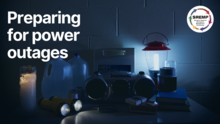Preparing for power outages

Many of Alberta’s hazards, such as high winds, freezing rain, and flooding, can damage power lines causing power outages.
Outages can leave you without heat, hot water, lights, air conditioning, information services, and vital communication channels. Services such as grocery stores, pharmacies, gas stations, banks, and ATMs may be closed during an extended outage.
Actions to take before a power outage
- Build an emergency kit.
- Make a household emergency plan.
- Download the Alberta Emergency Alert app for critical, life-saving alerts.
- Install a carbon monoxide alarm with backup battery power.
- Have back-up power for generators, heat and medical equipment.
Actions to take during a power outage
- Activate and follow your emergency plan.
- Get your emergency kit and keep it nearby.
- If the power is still on in your neighbourhood but not in your home, check your breaker. Call your utility provider to determine if the interruption is widespread or only affecting your property.
- Leave one light on inside and one light on outside so you and the utility worker will know when power has been restored.
- Prevent carbon monoxide poisoning. Generators, camp stoves and barbecues do not belong indoors, and gas stoves and ovens are not a safe source of heat.
- Listen to a local radio station for information from local authorities.
After a power outage
- Unplug appliances and electronics before turning on the main power switch.
- Allow the power to stabilize and wait 15 minutes before reconnecting tools and appliances.
- Turn the essentials on first. Start with heat, followed by the refrigerator and freezer.
- Connect with your utility provider for more information.
- Check all food for signs of spoilage and damage. When in doubt, throw it out. After 24 hours of no power, all refrigerated medication should be thrown out, unless the label says otherwise.
Printable resources
SREMP is a partnership between Sturgeon County, Morinville, Gibbons, Redwater, Bon Accord and Legal. These municipalities work together to coordinate emergency preparedness, response and recovery from disasters.
Leave A Comment